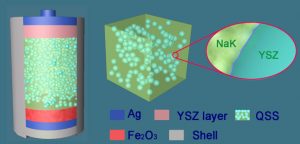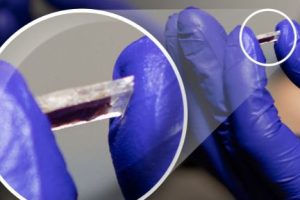
Having a battery running at 700-800°C might seem a little impractical.
“This molten salt battery has multiple feasible application directions, and transport is one of these,” Nottingham professor of electro-chemistry George Chen told Electronics Weekly. “It is indeed a high temperature battery, but the working temperature is actually about the same as the temperature of the engine exhaust gas from a petrol or diesel engine. In principle, maintaining the temperature can be achieved by the currents for charging and discharging of the battery, good thermal insulation and some additional electric heating if necessary. An older version of molten salt battery for transport application is the so-called Zebra battery in mid 1980s, whilst the more recent version is the so-called ‘liquid metal’ battery from MIT.”
Zebra and MIT batteries use liquid molten chemical salts, which steadily evaporate, and can spill or leak, according to Chen.
The difference between those and the new battery is that the researchers have found a way to convert that liquid to a thick paste – into what is known as a ‘quasi-solid-state’ – without much compromising electrolytic performance.
The paste is made by adding a solid powder to the electrolyte, which is a highly conductive (~0.42S/cm) molten mixture of sodium and potassium carbonates.
Normally, adding enough powder to solidify the liquid would badly compromise conductivity, but in this case the powder is itself conductive – nano-fine ‘yttrium-stabilised zirconia’ – with the result that conductivity stays at a useful ~0.22 S/cm.
The mixed carbonate liquid still evaporates out of the quasi-solid, but at half the rate it did before.
“So far, to the best of our knowledge, this is the first report on quasi-solid-state molten electrolyte for high-temperature metal-salt batteries,” said the research team in the scientific paper ‘Quasi-solid-state electrolyte for rechargeable high-temperature molten salt iron-air battery‘, published in the journal Energy Storage Materials.
The 800°C proof-of-concept iron-oxygen battery showed high capacity and, aside from some electrolyte evaporation, no significant deterioration in capacity over 80 charge-discharge cycles.
“Energy densities of our battery is comparable with that of lithium-ion batteries, but ours offers a higher power density and longer discharge-charging cycle life, and also better safety in terms flammable materials,” said Chen – the paper puts energy density at 380Wh/kg, and columbic efficiency above 90%.
Yttrium is a rate-earth and not particularly abundant.
“There is no yttrium metal in the battery, but the electrolyte contains yttria-stabilised zirconia, which is the same ceramic solid electrolyte used in solid oxide fuel cells,” Chen said. “The content of yttrium element in this ceramic is about 3-5% in weight, and the ceramic used in our battery is completely recyclable.”
According to Nottingham, other potential uses are domestic to grid-scale storage of energy from renewable sources and, in principle, it might also be used to store solar-derived heat as well as electricity. “Molten salts are currently used at large scale in Spain and China to capture and store solar heat which is then converted to electricity – our molten salt metal air battery does the two jobs in one device,” said Chen.
Nottingham UK worked with: Shanghai Institute of Applied Physics, University of Chinese Academy of Sciences, Dalian National Laboratory for Clean Energy, Soochow University, Anhui University, China Academy of Engineering Physics and University of Nottingham Ningbo China.
 Electronics Weekly Electronics Design & Components Tech News
Electronics Weekly Electronics Design & Components Tech News




And we though the sodium sulphur battery was exciting enough.
I don’t like the look of the bit that says: ” aside from some electrolyte evaporation”. Does that mean that future cars are going to rust away from the inside of wherever the battery will be situated as well as the outside?
Indeed Like Hear.
I can’t help thinking that this is not going anywhere until it is a sealed system, at least for cars.
I wonder if lorries might be a better fit – more room for all that insulation, and a mugh higher percentage of time on the road ( and room for an electrolyte chimney?)